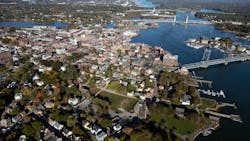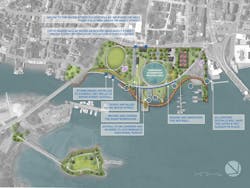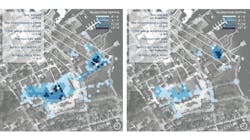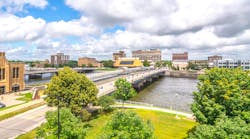Parks are more than just one thing and serve more than one function; they are agents for physical change in communities. Public spaces must be promoted as part of larger infrastructural and resiliency systems in our cities.
At a base level, infrastructure is what helps a city operate, providing access to things like clean drinking water, roads, and electricity. Parks, be it through providing recreational access, generating cleaner air, or acting as a flood control measure, must be conceptually repositioned as critical infrastructure to prepare cities for the challenges of climate change.
The momentum for this type of change is already in place and the planning for Prescott Park in downtown historic Portsmouth, N.H. is a perfect example of the right blend of collaboration, expertise, and cultural awareness to carry it through.
As the impacts of climate change-driven sea level rise and intensifying storms become more severe, the first lines of defense in many coastal areas are our waterfront parks and open spaces. Such is the case with city-owned 10-acre Prescott Park, with over 1,150 linear feet of tidal waterfront on the Piscataqua River.
Design-engineering firm Weston & Sampson was contracted by the city as planning efforts began in 2016 to develop a master plan that allows the park to function better, to strengthen its role as an arts venue, and to reduce overall flooding. The proposed resiliency approach is three-fold: 1. Protect the park along its seawall edge; 2. Retreat critical infrastructure; and 3. Accommodate for flooding. Collectively, these improvements are expected to mitigate flooding impacts for the entire neighborhood in the future.
Why Now?
Today, Prescott Park’s aging waterfront infrastructure does not adequately mitigate flooding in the park and the surrounding neighborhood. This challenge will only become more pronounced as projected sea level rise continues and intense rainfall events increase in frequency.
For the currently modeled 25-year, 24-hour design storm, most flooding occurs upgradient of Prescott Park, with only minor flooding within the park itself thanks to its existing dry wells. This trend remains true through mid-century. By the late 21st century (2090-2100) however, the pattern of flooding for the 25-year, 24-hour storm is expected to change significantly as sea level rise impacts the tidal Piscataqua River and surcharges the park’s drainage system through its several outfalls.
What Are the Flood Risk Considerations?
The project team evaluated coastal flood risk from sea level rise and storm surge, as well as inland flooding risk due to extreme precipitation.
The future planning horizons include both 2050 to correspond to the likely useful life of the park’s programming and 2100 to evaluate longer-term climate impacts. Two recurrence intervals were selected: the 10-year and 100-year storms. These studies informed the climate resilient and stormwater interventions to be implemented together as part of the first phase of improvements, including:
Protect: Install tide gates at all existing outfalls to prevent tidal backflow, and stabilize and raise the seawall in critical locations (to elevation 10.6 based on the year 2050 high sea level rise scenario).
Retreat: Raise and relocate the historic 1806 Shaw Warehouse out of its vulnerable position.
Accommodate: Regrade the arts festival performance lawn to concentrate flooding, regrade around the Shaw Warehouse to direct runoff, construct a new 24-inch diameter storm drain running the length of Water Street, and upsize the existing 24-inch diameter storm drain to a 36-inch pipe under the performance lawn.
Regrading the park and making the stormwater management improvements will shift and reduce significant flooding. Water will collect in the proposed above-ground storage area of the performance lawn area and, to a lesser degree, on Water Street immediately adjacent to the Shaw Warehouse, where it can be collected into the proposed 24-inch-diameter storm and associated catch basins.
The proposed regrading plan will also eliminate ponding in the historically flood-prone Marcy-Water Street intersection bordering the park, and significantly decrease impacts to the park’s historic buildings during moderate storm events (e.g., 10-year storm). By upsizing the 24-inch diameter central conduit beneath the performance lawn to a 36-inch storm drain, flooding will also be reduced during more extreme events (e.g., 50-year storm) and mid-century climate scenarios.
Overall, the stormwater interventions are predicted to reduce flooding by 97 percent in the park and by 39 percent in the surrounding streets by 2090.
How Can this Strategy be Applied Elsewhere?
The improvement plan for Prescott Park captures the complexity of contemporary resilient design: strategies must be cohesive and highly site-specific. When considering a stormwater resiliency approach, there are three important themes.
1. Engineered climate solutions should work not just for today, but for the future. Many approaches to climate change seek immediate results without considering the long-term consequences, resulting in damage to local biodiversity and separating environments from the communities they are intended to protect. Resiliency design can bolster the connection between people and places by strategically deploying a multifaceted response. A diverse approach to resiliency design can improve biodiversity, strengthen a site’s ability to grapple with increasingly severe weather events, and incorporate the public’s needs at the same time. Climate change will impact our communities in a variety of ways — our response to climate change must be just as varied.
2. Resiliency engineering and design go hand in hand. Climate engineering and design, often thought of as two separate spheres, are most successful when they work in tandem. Whereas a purely engineering or design response might propose different solutions to a problem, a joint design-engineering approach compounds multiple types of expertise into a dynamic yet grounded approach. Assembling design teams with a range of skills is key to successful climate interventions.
3. Public parks are an essential component of public infrastructure. With parks becoming increasingly programmed to mitigate climate change and ostensibly serving more civic functions than ever before, they must be understood as a part of our public infrastructure. Just as people expect water when they turn on the tap or a light bulb to illuminate with the flip of a switch, they also expect their neighborhoods not to fill with floodwater. Parks provide a public utility and a public good. Cities must recognize that outdoor spaces are fundamental components of what residents expect of a functioning city.
Through this Prescott Park master planning effort by the city, the design team had agency to devise a resiliency strategy resulting in bold and tangible benefits for the surrounding historic South End neighborhood. The park’s need for a significant resiliency intervention is foundational to the master plan’s vision and is prioritized. Prescott Park’s multi-layered resiliency approach could become a model for other communities challenged with similar issues. SW
Published in Stormwater magazine, August 2022.








